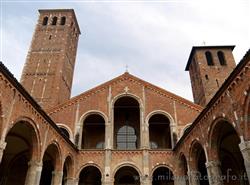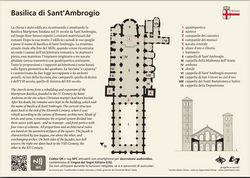|
Basilica of Sant'Ambrogio
|
|
|
Show an other treasure of art and history in Milan:
|
 Mostly represented styles: Paleochristian - Romanesque Mostly represented styles: Paleochristian - Romanesque
After the Cathedral, the Basilica of Sant'Ambrogio is certainly the most important church of Milan. Through it passes the entire history of the city, starting from the time when the city belonged to the Roman Empire to the Second World War and its destructions.
The basilica has undergone countless changes, renovations and restorations, so that the description of its structure and its history is very complex.
Despite that, curiously, the Basilica of Sant'Ambrogio is the only Romanesque church of Milan not to have undergone the renovation of its facade in the nineteenth century.
History and general structure
The oldest part of the complex is represented by the Shrine of San Vittore in Golden Sky (first photo from the left of the second line), built in the fourth century by Bishop Maternus to preserve the remains of St. Victor and important example of early Christian architecture.
Adjacent to it, heading north, the bishop of Milan Ambrose built, between 379 and 386, the Martyrum Basilica, the first version of the early Christian basilica, whose name came from the fact that it was built in an area where martyrs of the Roman persecutions had been buried. The name was changed to the present one later when Ambrose was buried inside it.
The current version of the Romanesque basilica with three naves with vaulted ribbed cruise, is characterized by an alternating system of major and minor pillars that allow the transition from four spans in the main nave to eight in the lateral naves.
However, there is no agreement on the exact dating of almost all structural parts of the basilica, in the light of the many changes that have taken place over the centuries.
The absidiale part is in any case the oldest part, assigned to the centuries VIII, IX or X depending on the author.
In order not to be obliged to give an account of all the opinions of various experts, we won't further analyze the history of the church's changes. We add only that the church was heavily damaged during the bombings of the Second World War, which destroyed in 1943 especially the outside of the porch, damaged the dome of the basilica and other areas of the basilica complex, and caused the loss of significant art works, including a fresco by Tiepolo that decorated the ceiling of the sacristy.
Immediately after the war the restoration works took start. They were completed in the fifties, bringing the church to its former glory.
As for the current structure, outside the Basilica of Sant'Ambrogio is presented as a complex of buildings, all built entirely in brick.
To reach the main entrance you have to go through a large portico characterized by elegant arches supported by pillars flanked by half-columns. The capitals include both pre-Romanesque decorative elements (such as weaven elements) and zoomorphic elements and plants.
Along the walls of the atrium a remarkable lapidary collection is arranged, including early Christian inscriptions, Roman and Romanesque capitals, fragments of frescos (XII - XIII century), coats of arms and shields of noble Milanese families and tombstones.

The façade is gabled, broad and flattened and has two loggias. The lower one has three equal arches and rejoins the inside perimeter of the porch, although this has slightly higher arches, while the upper part has five arches of declining height following the sloping profile of the roof. Its most distinctive feature, however, are the degrading windows identical to the corresponding openings in the loggia.
Furthermore there are two bell towers of different heights, the right bell tower, said of the monks, dates from the eighth century and posses the austere appearance typical of a defensive towers. The left one, called of the canons, is higher and dates back to 1144, but two floors and a three-light loggia were added to it in 1889.
The interior of the basilica has a simple rectangular plan and has very similar dimensions to those of the portico. There are three naves with apses, with an elevated presbytery over the crypt, surrounded by the tiburium.
The centeral nave, twice as large as the lateral naves, is divided into four square spans. The first three are covered by vaults whose terracotta ribs with square section start from clustered piers from which also the the arches of the side aisles start. The fourth vault, next to the presbytery, was later covered with a dome inserted inside an octagonal tiburium.
The lateral naves are formed by eight smaller spans; each of them has an area equal to a quarter of that covered by a span of the main nave. The roofs of the aisles are made of cross vaults. Above them there the matronea (women galleries). The aisles are in connection with the lateal chapels, with those on the left shallow and with a rectangular plan, those on the right deeper, with a central plan and sometimes with an apsis.
The apse is in elevated position above the crypt. At its entrance, the lower trunks of the pillars are a remnant of the columns of the triumphal arch of the original basilica.
The apse has a beautiful mosaic decoration, built between the fourth and eighth centuries, with interventions in the eighteenth and twentieth century. In the center of the mosaic there is Jesus Christ, blessing enthroned between two angels and the saints Gervasio and Protasio.
The crypt is probably coeval with the choir, but it also can't be dated with certainty, except regarding the enlargement due to interventions in the eighteenth century, promoted by Cardinal Benedetto Erba Odescalchi, archbishop of Milan, and in the nineteenth-century, the ones that followed the discovery of the ancient sarcophagus and the relocation of the bodies of St. Ambrose and Sts. Protasio.
The Basilica of Sant'Ambrogio houses many treasures of art and history that are worth a specific description.
Shrine of San Vittore in Ciel d'Oro
(Shrine of Saint Victor in Golden Sky) As mentioned, it corresponds to the oldest part of the basilica, going back even to Roman times. Built to house the remains of St. Victor (whose portrait is in the center of the dome), later it received those of St. Satyr, brother of Sant Ambrogio. In the mosaics on the walls are represented various saints, including Gervase, Ambrose and Protasus on the left wall. Dating from the late fifth century, Ambrose is in them still represented with great realism.
The shrine is almost square-shaped, with semi-circular apse and clay pipes dome. The interior of the dome is filled by a mosaic of golden background, hence the name.
Sarcophagus of Stilicho
It is the large sarcophagus located under the pulpit, on the left side of the main nave (both visible in picture 4). Also the Sarcophagus of Stilicho dates back to the early Christian era and impresses with fantastic bas-reliefs that decorate its walls. They depict, among other things, Jesus and the doctors of the Church (or apostles, according to another interpretation), Elijah and the Fiery Chariot, Adam and Eve, Noah, Moses.
The sarcophagus probably belonged to the basilica from the beginning, although its original position was different.
The pulpit
above it is of uncertain age (IX-XII). Hit the eagle and the character, embossed copper partially gilded. They are pre-Roman era and should symbolize the evangelists John and Matthew, although the eagle could also symbolize the resurrection.
The complex of altar and ciborium
It is the focal point of the basilica.
The oldest of them is the ciborium, whose columns are surely even of Roman times. The upper part, however, is of more uncertain dating. Some date it back to the sixth century, others to the ninth century.
Some researchers have highlighted the typical Byzantine structure of the dome.
Its main side depicts the Traditio Legis, i.e. Christ delivering the keys to Peter and the book to Paul.
About who are the people depicted on the other sides there is rather more uncertainty.
The golden altar represents an extraordinary example of Carolingian goldsmith art. It was donated to the basilica by the bishop Angilbertus, represented in one of two little doors in it, in the first half of the ninth century.
The work is signed by "Vuolvinius phaber magister" (hence the name "Altar of Volvinius"), who also wanted to portray itself on one other door.
The altar has the side towards the church covered with gold foil, while the other sides are covered with silver foil partially golded. The golden side depicts episodes from the life of Christ, while on the back there are episodes of Ambrose's life.
Curiously, the more accurate part is the rear one, while the others, including that covered with gold, were evidently not made by the master, but by his assistants.
The side chapels
The side chapels were obviously built much later than the basic Romanesque structure of the basilica, as it can be easily guessed from the decorations that adorn them. Their addition was part of the enlargement project put in place by Bramante (which included the cloisters for the monks, now Catholic University, the unfinished porch of the rectory and other spaces remained at the level of project).
Like the whole basilica, they also contain many works of art of great value, including frescoes by Tiepolo (in the chapel before the Shrine of St. Victor), Bernardino Lanino and Bergognone (Dead Christ between two angels, in the first chapel on the left). The Antechapel of the Shrine of San Vittore is worth a special mention. It was completed in 1738, it is decorated with beautiful frescos and is closed by a wrought iron gate of the eighteenth century (photo 7).
We must finally mention the Museum of Sant'Ambrogio, which houses the treasure of the basilica and many ancient works of the early church.
Other pictures taken during a guided tour
For further info (only Italian):
If you are interested in a guided tour of this monument send an email!
Categories: Churches / Religious buildings Roman Milan
Piazza Sant'Ambrogio, 15, 20123 Milano |
Further pictures of the Basilica of Sant'Ambrogio in the section Photography |